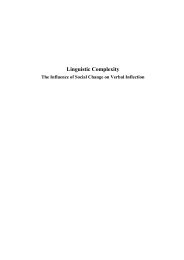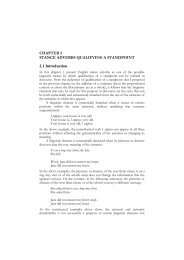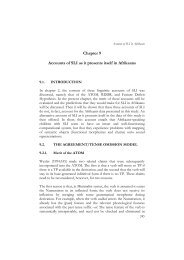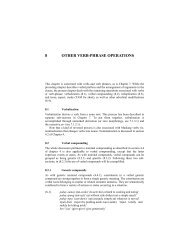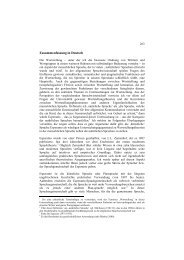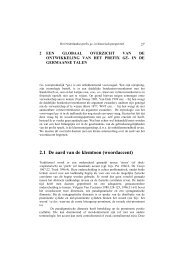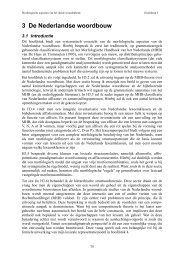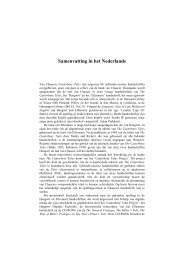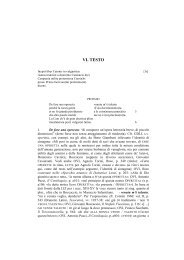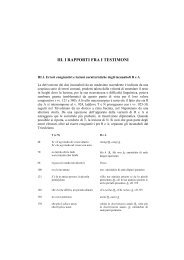Chapter 3 - LOT publications
Chapter 3 - LOT publications
Chapter 3 - LOT publications
You also want an ePaper? Increase the reach of your titles
YUMPU automatically turns print PDFs into web optimized ePapers that Google loves.
<strong>Chapter</strong> 3<br />
Pseudo-coordinative try and<br />
reduplicative coordination<br />
I have demonstrated that pseudo-coordination is a diverse phenomenon. However,<br />
there are two questions that spring to mind when confronted with the typology developed<br />
this far. The first question is whether or not there are other types of pseudocoordination<br />
in addition to ConCo and SceCo. The second question is whether there is<br />
any additional motivation for the existence of any particular pseudo-coordinative type<br />
like, say, ConCo.<br />
With respect to the first question, I will attempt to expand the proposed typology<br />
to include pseudo-coordinations with conative try. These exhibit interesting characteristics<br />
that distinguish them from the ConCo and SceCo constructions discussed in<br />
chapter (2). In the following chapter I will discuss these characteristics in order to<br />
place pseudo-coordinative try more accurately in the typology being developed.<br />
Concerning the second question, I will discuss data which have hitherto not been<br />
discussed under the rubric of pseudo-coordination. This new data is of a reduplicative<br />
nature. The properties of these will also be discussed because they are particularly<br />
interesting with respect to ConCo. In exploring these new data, the existing typology<br />
will be consolidated.<br />
3.1 The putative uniqueness of try<br />
We are now in a position to explore a less canonical example of pseudo-coordination,<br />
namely pseudo-coordination with conative try.<br />
(1) a. John will try and kiss Mary at the party tonight<br />
b. Who will John try and kiss at the party tonight?<br />
There are two main reasons why I would like to deal with conative try separately.<br />
Firstly, it seems different to other pseudo-coordinative structures in a number of respects.<br />
For instance, one immediate difference between structures with conative try
56 The putative uniqueness of try<br />
and other ConCo constructions is that conative try constructions can be paraphrased as<br />
infinitives. 1 In contrast, ConCo constructions can only be paraphrased with a purposeadjunct<br />
reading.<br />
(2) a. John will try and eat an apple [Conative try]<br />
b. John will try to eat an apple<br />
‘*John will try, in order to eat an apple’<br />
(3) a. John will go and eat an apple [ConCo]<br />
b. John will go to eat an apple<br />
‘John will go, in order to eat an apple’<br />
(4) a. John will sit and eat an apple [ConCo]<br />
b. John will sit to eat an apple<br />
‘John will sit, in order to eat an apple’<br />
Secondly, despite their atypicality, examples with try have informed a number of<br />
studies (e.g. Carden and Pesetsky (1977)) adding to the confusion between ConCo and<br />
SceCo and leading to incorrect generalizations. For these reasons I consider it vitally<br />
important to establish the place of conative try in the typology I have developed. To<br />
this end, I will apply the tests developed in the first part of this chapter. I will show<br />
that conative try constructions differ from ConCo constructions with sit and go in most<br />
respects.<br />
3.1.1 Morphological conditions<br />
Another salient and curious difference between conative try and ConCo and SceCo<br />
is that it cannot tolerate any inflection (Carden and Pesetsky 1977, Schmerling 1975).<br />
Only the bare forms of the verbs can occur in this construction. The same is not true of<br />
other ConCo verbs like sit and go. 2 The following examples illustrate this with respect<br />
to bare verbs, present tense, past tense and participle morphology.<br />
(5) a. John will try and eat an apple [Conative try]<br />
b. John will go and eat an apple [ConCo]<br />
c. John will sit and eat an apple<br />
(6) a. *John tries and eats an apple [Conative try]<br />
b. John goes and eats an apple [ConCo]<br />
c. John sits and eats an apple<br />
1 This idea is expressed as far back as Gleitman (1965).<br />
2 Pullum (1990) notes that try and V constructions act like bare aspectual come and go (Jaeggli and<br />
Hyams 1993) in being subject to a morphological condition prohibiting inflection on these forms.
Pseudo-coordinative try and reduplicative coordination 57<br />
(7) a. *John tried and ate an apple [Conative try]<br />
b. John went and ate an apple [ConCo]<br />
c. John sat and ate an apple<br />
(8) a. *John has tried and eaten an apple [Conative try]<br />
b. John has gone and eaten an apple [ConCo]<br />
c. John has sat and eaten an apple<br />
(9) a. John and Mary try and eat apples [Conative try]<br />
b. John and Mary go and eat apples [ConCo]<br />
c. John and Mary sit and eat apples<br />
Thus conative try differs from SceCo and ConCo with respect to the morphology<br />
condition. Note that because try cannot be inflected, I will use either a plural subject<br />
or a modal verb in most of the examples in this chapter.<br />
3.1.2 Extraction<br />
It is possible to extract both arguments and adjuncts from conative try constructions.<br />
Thus conative try has properties identical to ConCo with respect to extraction (see<br />
section (2.1.1)).<br />
(10) Who do you think will try and kill the Pope?<br />
(11) Who will they try and kill?<br />
(12) How much will they try and pay the assassin?<br />
(13) How badly did they try and behave?<br />
3.1.3 XPs in the verbal string<br />
XPs cannot occur in Position B within the verbal string and somewhat marginally in<br />
Position C. This contrasts with the contiguous nature of ConCo (section (2.1.2)).<br />
(14) a. Bafana-Bafana tried and, in 2001, won the African cup<br />
b. *What do they try and, in 2001, win?<br />
(15) a. What do they carefully/regularly/never try and eat?<br />
b. *What do they try carefully/regularly/never and eat?<br />
c. What do they try and ?carefully/regularly/never eat?
58 The putative uniqueness of try<br />
3.1.4 Restrictions on subjects<br />
Conative try constructions seem to require an obligatorily sentient subject. Consequently,<br />
it is incompatible with the expletive subject of weather verbs and with nonsentient<br />
objects such as trees (unless one imputes consciousness to them). This makes<br />
try seem rather more like a SceCo verb (section 2.1.3).<br />
(16) John will try and become a pilot<br />
(17) *I wonder if it will try and rain today<br />
(18) *The acorn will try and become an oak<br />
3.1.5 Semantic bleaching<br />
There does not seem to be much semantic bleaching of try per se. For instance, there<br />
does not seem to be any significant semantic difference between pseudo-coordination<br />
with conative try and the corresponding infinitival construction. The following example<br />
is (2) repeated for convenience.<br />
(19) a. John will try and eat an apple [Conative try]<br />
b. John will try to eat an apple<br />
Moreover, conative try does not seem to exhibit bleaching independently of pseudocoordinative<br />
constructions; in fact, it is not at all clear to me what a ‘bleached’ semantics<br />
of try would correspond to. Given the lack of semantic bleaching, conative try<br />
seems quite similar to SceCo.<br />
Paradoxically, however, conative try contexts are intrinsically different from SceCo;<br />
SceCo implies a sequence of events, where the pseudo-coordinative verb denotes an<br />
event that sets the scene for the main activity to take place. Where conative try is used,<br />
however, the trying event must necessarily be cotemporaneous with the main activity.<br />
In this respect constructions with conative try are like ConCo constructions.<br />
3.1.6 VP deletion<br />
In VP deletion contexts with conative try, it is not necessary that try obligatorily be<br />
deleted with the rest of the VP. This sets try apart from ConCo constructions and<br />
makes it similar to a SceCo predicate (section (2.1.5)).<br />
(20) a. They will try to kill mosquitos and Mary will too<br />
→ ‘Mary will also try to kill mosquitos’<br />
b. They will try and kill mosquitos and Mary will try too<br />
→ ‘Mary will also try to kill mosquitos’
Pseudo-coordinative try and reduplicative coordination 59<br />
3.1.7 Coordinator substitution<br />
The coordinator cannot be substituted by another in conative try constructions. This is<br />
a characteristic shared by all pseudo-coordinative structures (section 2.1.6) and indicates<br />
that conative try constructions are not a special case of OCo.<br />
(21) a. John will try and kill mosquitos<br />
b. *John will try or kill mosquitos<br />
3.1.8 Semantic subordination<br />
In conative try constructions, as for ConCo and SceCo, the activity denoted by the first<br />
predicate (try) is semantically subordinate to the main activity denoted by the lexical<br />
verb, in the sense of Na and Huck (1992). This is reflected in the fact that the conjuncts<br />
of a conative try construction cannot be reordered. This is a common property of all<br />
pseudo-coordinative constructions (section (2.1.7)).<br />
(22) a. John will try and kill mosquitos<br />
b. *John will kill and try mosquitos<br />
c. *John will kill mosquitos and try<br />
3.1.9 Distributivity<br />
Conative try constructions do not allow both modification. This shows that there is a<br />
semantic dependency between the verbs since the distributor requires to verbs denoting<br />
independent events (section (2.1.8)). This too shows that conative try constructions<br />
are not instances of OCo.<br />
(23) a. *John will both try and kill mosquitos<br />
b. *What will John both try and kill?<br />
3.1.10 Quantifier raising<br />
Conative try constructions allow quantifier raising, thereby yielding both wide and<br />
narrow scope readings. This is not surprising since conative try is not a selective island.<br />
This property is also common to ConCo constructions (section (2.1.9)).<br />
(24) A policeman will try and kiss every widow<br />
‘Some policeman will attempt to kiss every widow’ [NS]<br />
‘For every widow, some policeman or other will attempt to kiss her’ [WS]
60 The putative uniqueness of try<br />
3.1.11 Counter-expectational readings<br />
Instances of conative try do not seem to yield any particular counter-expectational<br />
readings. Thus (25) appears to be completely neutral in this regard. In this respect,<br />
conative try constructions pattern with SceCo (section (2.1.12)).<br />
(25) John will try and eat an apple<br />
3.1.12 Phonological cues<br />
The coordinator may reduce to syllabic [n " ] in ConCo constructions with try (Carden<br />
and Pesetsky 1977). WH extraction is used to force a pseudo-coordinative reading.<br />
(26) a. John will try and he will catch Harry<br />
b. John will try [@n] he will catch Harry<br />
c. *John will try [n " ] he will catch Harry<br />
(27) a. Who will John try and catch?<br />
b. Who will John try [@n] catch?<br />
c. Who will John try [n " ] catch?<br />
Once again, as I mentioned in section (2.1.13), these facts may have a phonetic<br />
explanation. Thus, until more is known, these facts should be treated cautiously.<br />
With respect to focus, constructions with pseudo-coordinative try behave slightly<br />
differently to other pseudo-coordinative constructions. It is indeed possible to focus<br />
the first verb, namely try. It remains impossible to focus the coordinator.<br />
(28) a. Why don’t you at least try and EAT something?<br />
b. Why don’t you at least TRY and eat something?<br />
c. *Why don’t you at least try AND eat something?<br />
3.1.13 Findings<br />
The findings of this section are summarized in table 3.1 on the facing page.<br />
Firstly, it is very clear that conative try constructions do not pattern with OCo but<br />
are a pseudo-coordinative structure of some sort. This is indicated by, among other<br />
things, extraction in non-ATB contexts, quantifier raising, the ban on XPs and subjects<br />
in the verbal string, coordinator substitution, the inability to change the order of the<br />
conjuncts and the incompatibility with distributors.<br />
Secondly, although conative try does have certain characteristics in common with<br />
ConCo (namely extraction of adjuncts and quantifiers and phonological reduction),<br />
other tests preclude the possibility that conative try constructions are ConCo structures.<br />
ConCo exhibits properties of constituenthood (partial VP-deletion test, XP-incluster<br />
test etc.), a fact exploited in my analysis in chapter (4). Since conative try
Property Section OCo SceCo try ConCo<br />
Syntactic tests<br />
Non-ATB argument extraction (3.1.2) No <br />
Non-ATB adjunct extraction (3.1.2) No No <br />
XPs in Position B (3.1.3) No No No<br />
XPs in Position C (3.1.3) (Some) Some (?) No<br />
Partial VP-ellipsis (3.1.6) No<br />
Coordinator substitution (3.1.7) No No No<br />
Semantic tests<br />
Subject restricted by Verb A (3.1.4) No<br />
Semantic bleaching of Verb A (3.1.5) No No No <br />
Semantic subordination (3.1.8) No <br />
Distributivity (3.1.9) No No No<br />
Wide-scope reading of quantifier (3.1.10) No No <br />
Restrictions on possible Verb A No <br />
Inherent counter-expectational reading (3.1.11) No No No (go)<br />
Morphological and Phonological tests<br />
Morphological Sameness (3.1.1) No N.A. <br />
Focus on Verb A (3.1.12) No (?) No<br />
Focus on coordinator (3.1.12) No (?) No No<br />
Table 3.1: Summary of tests including try<br />
Pseudo-coordinative try and reduplicative coordination 61
62 Reduplicative coordination constructions<br />
structures readily allow partial VP-deletion, they cannot form a constituent with the<br />
lexical predicate. Finally, whereas ConCo predicates exhibit semantic bleaching and<br />
do not affect the selectional relationship between the verb and the subject, conative<br />
try does not appear to be bleached at all and strongly selects for an animate, sentient<br />
subject. Thus, it cannot be analysed as a typical ConCo construction.<br />
Thirdly, there are important characteristics that make conative try quite similar<br />
to SceCo. I have already alluded to some of these. They include the lack of semantic<br />
bleaching, the selectional relationship between the verb and its subject and partial VPellipsis.<br />
On the other hand, the ability to extract adjuncts and quantifiers freely, not to<br />
mention the peculiar morphological constraints on the conative try construction make<br />
me reluctant to classify it as SceCo. These data lead me to conclude that conative<br />
try is yet another type of pseudo-coordination which is distinct from both SceCo and<br />
ConCo.<br />
At this point, we have identified at least four different types of verbal coordination:<br />
OCo, SceCo, ConCo and pseudo-coordinative try. These are schematized in figure 3.1.<br />
Figure 3.1: Pseudo-coordination, including try<br />
Coordination<br />
✥✥✥❵❵❵❵❵<br />
✥ ✥✥<br />
❵<br />
Ordinary Coordination Pseudo-coordination<br />
✘✘❳<br />
❳❳❳<br />
✘✘ ✘✘<br />
❇ ❳❳<br />
SceCo ConCo try<br />
✦<br />
✦❛❛<br />
✦ ❛<br />
sit, go, come . . .<br />
3.2 Reduplicative coordination constructions<br />
At this point, having developed tests to distinguish ConCo from superficially similar<br />
constructions like SceCo, we are now in a position to explore another V and V construction<br />
which may shed some light on ConCo. With this in mind, let us step back<br />
from ConCo of the go, sit type and consider Reduplicative coordination (ReCo). 3<br />
(29) He begins reading about dinosaurs and tigers, and he reads and reads until the<br />
library closes<br />
(http://www.whitehouse.gov/news/releases/2003/05/20030520-17.html (12.10.2004))<br />
(30) My friend Jim Stoltz walks and walks and walks in the wilderness<br />
(http://www.walkinjim.com/wwbookart_book.html (14.10.2004))<br />
(31) Starsky pulls his revolver from his shoulder holster and shoots and shoots at<br />
Huggy Bear (http://www.g21.net/cc14.html (01.07.2005))<br />
3 It has also been called Augmentative conjunction Haspelmath (2005).
Pseudo-coordinative try and reduplicative coordination 63<br />
ReCo constructions typically reduplicate activity verbs, example (31) notwithstanding.<br />
4 However, example (31) does raise a pertinent question: does durativity license<br />
iterativity or vice versa. This question requires the sketching of the relationship<br />
between ReCo and pluractionality.<br />
There are many similarities between ReCo and pluractionality – so-called plural<br />
marking on verbs. Many languages have verbal affixes which are:<br />
frequently reduplicative, most often derivational rather than inflectional,<br />
and expressing a broad range of notions typically including action by<br />
more than one individual, temporally iterated action and spatially scattered<br />
action (Lasersohn 1995:238).<br />
Among the meanings associated with pluractionality are repetitiveness, repeated<br />
occasions or events, conation, persistent consequences, habitual agency, distributed<br />
quality, inchoativity, cumulative result, intensity, plurality of sites of action, duration,<br />
continuity, distribution, celerativity/retardativity, augmentation, diminution as<br />
well as perfectivity, causativity and plurality of subject or object noun phrases (Cusic<br />
1981:74–75).<br />
This enumeration of properties bears many similarities, not only with ReCo, but<br />
also with ConCo more generally. However, a central question is which of these readings<br />
is primary because the answer relates directly to the types of analyses that can be<br />
proposed. Whereas Cusic (1981) and others have regarded pluractionality as having<br />
a fundamental meaning of combining different events (i.e. iterativity), I want to approach<br />
ReCo in English from the opposite direction. I will regard it as coordinating,<br />
not discrete events, but substages of the same event. 5 From this basic meaning, the<br />
iterative readings more typical of pluractionality can be easily derived by the analysis<br />
I will propose. There are empirical reasons for this approach which are reviewed in<br />
the following section.<br />
3.2.1 Empirical reasons to favour durativity over iterativity<br />
To answer the question of whether ReCo constructions are primarily durative or iterative,<br />
consider the following minimal pair.<br />
(32) a. John looked up and looked up at the sky but never saw a comet<br />
4 ReCo can also occur with non-verbal material as the following examples show. Crucially, it is durative<br />
aspect that licenses reduplication in these contexts. They are discussed more fully in section (4.5).<br />
(1) The balloon went up and up<br />
(2) The plane flew around and around the airfield<br />
(3) Merlin slept for years and years<br />
(4) John slept (*about/*in/for) hours and hours<br />
(5) Eternity lasts for ever and ever<br />
5 Needless to say, I am not making a general claim about pluractionality in all languages. My claim<br />
holds for the ReCo constructions under discussion. However, whether the claim can be extended to other<br />
pluractional-marking languages is an interesting one, worthy of more exploration.
64 Reduplicative coordination constructions<br />
b. *John looked up and looked up from his work<br />
Examples (32a,b) are a minimal pair. Since the reduplicated predicates are syntactically<br />
identical, the grammaticality distinction between them must be derived from<br />
semantics and not from a purely syntactic explanation. Thus, it is the semantics of the<br />
constructions that license reduplication. 6 To look up from work is an activity that is<br />
easily repeated as demonstrated by example (33a), the particle predicate itself cannot<br />
be reduplicated (33b).<br />
(33) a. John looked up from his work repeatedly<br />
b. *John looked up and looked up from his work<br />
If ReCo were inherently iterative in its semantics, then examples like (33b) would<br />
be predicted to be grammatical. The fact that (33b) is ungrammatical shows that mere<br />
iterative potential is not sufficient to license reduplication.<br />
However, ReCo does have durative, atelicity as an inherent part of its semantics.<br />
For this reason it is only possible to reduplicate durative predicates. Thus look up at the<br />
sky (32a) can be construed duratively whereas look up from work (32b) cannot; only<br />
the former can be reduplicated. Thus, it is the ability to be interpreted duratively, rather<br />
than iteratively that is a good predictor of the grammaticality of ReCo constructions.<br />
This is not to say that iterative readings never occur in ReCo contexts; they do.<br />
However, an iterative reading is parasitic on durativity and can only be licensed in circumstances<br />
where a durative reading is pragmatically unlikely, as occurs with punctual<br />
events. In effect then, an iterative or serial reading is a strategy by which a punctual<br />
event can be construed as durative. For instance, in (34), the plurality of the subject<br />
licenses a serial reading, while the singular subject in (35) licenses an iterative reading.<br />
(34) The police shot and shot at the protesters<br />
(35) John shot and shot at the rabbit<br />
And yet there is still another reading associated with ReCo constructions: intensiveness.<br />
Whenever ReCo occurs it typically means not only that a particular activity<br />
is durative, but that it is done to a large, excessive or intensive degree. Thus the shoot<br />
and shoot examples above differ from ordinary progressives insofar as the former but<br />
not the latter imply that the shooting was somehow excessive.<br />
(36) The police shot and shot at the protesters<br />
(37) The police were shooting at the protesters<br />
6 This is supported by the fact that durative aspect licenses doubling of DPs more generally, whereas<br />
bounded events do not.<br />
(1) a. John read (the book) for days and days<br />
b. *John read the book in days and days
Pseudo-coordinative try and reduplicative coordination 65<br />
In summary, then, ReCo constructions have as primary meanings, durativity and<br />
intensiveness. The serial reading, when it exists, is parasitic on these two meanings.<br />
This gives us an explanation for why certain particle verbs can be reduplicated<br />
while others simply cannot. The following events, although potentially durative, simply<br />
cannot be carried out in an ‘intensive’ manner.<br />
(38) a. ??John climbed up and climbed up the mountain<br />
b. ??John climbed up the mountain intensively<br />
(39) a. *John went off and went off into the sunset<br />
b. *John went off intensively<br />
(40) a. *John put down and put down the book<br />
b. *John put down the book intensively<br />
(41) a. *John looked up and looked up from his work<br />
b. *John looked up from his work intensively<br />
(42) a. *John walked away and walked away<br />
b. *John walked away intensively<br />
In contrast, the activities denoted by the following particle verbs can be done in<br />
an ‘intensive’ manner and they can also be reduplicated.<br />
(43) a. I can’t believe it! Just because Mary was a professor, John just sucked up<br />
and sucked up and sucked up<br />
b. John sucked up intensively<br />
(44) a. John read up and read up for weeks on the lawsuit<br />
b. John read up intensively<br />
(45) a. ??John danced around and danced around until he was exhausted<br />
b. John danced around intensively<br />
(46) a. John looked up and looked up at the stars but never saw a comet<br />
b. John looked up at the stars intensively but never saw a comet<br />
There are also some particle verbs whose grammaticality in ReCo contexts increases<br />
markedly when an ‘intensive’ reading is given by the context.<br />
(47) a. ??John called up and called up Mary<br />
b. The stalker called up and called up Mary until she was a nervous wreck<br />
There is one apparent exception to this observation.
66 Reduplicative coordination constructions<br />
(48) a. ?I can’t believe it! The government just puts off and puts off making any<br />
decisions on the pension crisis<br />
b. *The government put off making the decision intensively<br />
A predicate like put off is punctual and thus not compatible with a durative reading.<br />
For this reason an iterative reading is licensed. However, an adverb like ‘intensively’<br />
also cannot typically modify a non-durative predicate. Consider the following<br />
example with shoot.<br />
(49) *John shot the rabbit intensively<br />
This accounts for the ungrammaticality of (48b). Thus this example is not a counter<br />
example at all.<br />
To conclude, ReCo constructions denote durativity and intensiveness and consequently<br />
only predicates (including particle verbs) which are compatible with both durativity<br />
and intensiveness may be reduplicated. In some cases, where a punctual activity<br />
like shoot is involved, then a serial reading is parasitic on the durative readings.<br />
Having discussed some general properties of ReCo, it is now possible to place it<br />
in its pseudo-coordinative context by systematically applying the tests developed in<br />
chapter (2). In this chapter I will demonstrate that<br />
i. ReCo is a pseudo-coordinative structure, i.e. that ReCo is not OCo and<br />
ii. ReCo shares many properties of ConCo.<br />
Because ReCo has not been analysed as pseudo-coordination before, I will first<br />
focus on demonstrating that ReCo is not OCo. To this end, I will not necessarily retain<br />
the tests in the order in which they were introduced in chapter (2). Tests that indicate<br />
that ReCo is not an instance of OCo include the inability to substitute one coordinator<br />
with another, the incompatibility of ReCo and distributive markers like both, the fact<br />
that ReCo conforms to the Morphological Sameness Condition (99), the possibility<br />
of non-ATB extraction and quantifier raising, and also the inability of a subject (or<br />
indeed any XP) to occur in the second conjunct.<br />
Other tests show that ReCo patterns with ConCo. These tests include the absolute<br />
ban on XPs within the verbal string, the incompatibility of ReCo with partial VPdeletion,<br />
semantic bleaching, and the fact that ReCo constructions allow quantifier<br />
raising.<br />
3.2.2 Coordinator substitution<br />
A classic test for pseudo-coordination is whether or not the coordinator can be replaced<br />
by another (section (2.1.6)). Whereas OCo allows such substitution, pseudocoordination<br />
does not. The following examples can be compared with examples (29),<br />
(30) and (31). They demonstrate unequivocally that ReCo structures do not allow coordinator<br />
substitution and are thus indeed pseudo-coordinative structures.
Pseudo-coordinative try and reduplicative coordination 67<br />
(50) a. *He read or read or read in the library<br />
b. *My friend walked or walked or walked in the wilderness<br />
c. *He shot or shot at Huggy Bear<br />
3.2.3 Distributivity<br />
In OCo structures, distributive markers such as both can occur. This is not possible<br />
in pseudo-coordinative contexts (2.1.8). Both modification is also blocked in ReCo<br />
constructions, exactly like their SceCo and ConCo counterparts. Thus ReCo is not<br />
OCo.<br />
(51) a. John both reads and writes books<br />
b. *John both reads and reads all day long<br />
3.2.4 The ‘Sameness’ Condition<br />
Another important characteristic of pseudo-coordination is that each of the predicates<br />
is subject to the Morphological Sameness Condition (99) on page 46. This condition<br />
also applies to ReCo. This is illustrated in (52) for PAST and (53) for participle morphology.<br />
(52) a. John sang and sang<br />
b. *John sang and sings<br />
c. *John sings and sang<br />
(53) a. John has sung and sung<br />
b. *John has sung and sings<br />
c. *John will sing and have sung 7<br />
3.2.5 Extraction<br />
ReCo constructions can have arguments extracted from them. Thus, just like ConCo<br />
and SceCo, they constitute exceptions to the CSC.<br />
(54) a. Who was the guy who sang and sang all night?<br />
b. What was the song that John sang and sang all night?<br />
7 This example is ungrammatical on a ReCo reading, but is still grammatical on a OCo reading.
68 Reduplicative coordination constructions<br />
It should be noted that ReCo examples can sometimes be a little clumsy. For instance,<br />
while an objectless ReCo construction is perfectly grammatical its counterpart<br />
with a direct object is sometimes less well-formed, but not outright ungrammatical. 8<br />
(55) a. John read and read<br />
‘John read (a book) but didn’t finish it’ [Durative, unbounded]<br />
*‘John read a book twice’ [Bounded]<br />
b. John read and read a book<br />
%‘John read a book but didn’t finish it’ [Durative, unbounded]<br />
‘John read a book twice’ [Bounded]<br />
Often, but not always, a ReCo construction with a definite object has a natural<br />
interpretation as a bounded predicate. For some speakers, this is most naturally interpreted<br />
iteratively (see also Rothstein 2004). The effect is ameliorated somewhat with<br />
indefinite objects. The reason for this is that verbs and direct objects are together construed<br />
as telic. Thus, the use of an object (and by corollary the extraction of an object)<br />
is relatively marked. Nevertheless, extractions of objects are grammatical as shown by<br />
examples like (54).<br />
It might be suggested that (54) is merely ATB extraction: in other words the subject<br />
is coindexed with two extraction sites, one in each conjunct. This would reduce ReCo<br />
to OCo. As has been demonstrated in section (2.1.1), ATB extractions cannot occur<br />
from pseudo-coordinative constructions. Consider the following examples illustrating<br />
extraction of benefactives.<br />
(56) a. The peasant kept trying to pump and pump and pump a glass of water for<br />
the soldier<br />
b. What did the peasant keep trying to pump and pump and pump for the<br />
soldier?<br />
c. Who did the peasant keep trying to pump and pump and pump a glass of<br />
water for?<br />
d. *Who did the peasant keep trying to pump for and pump for and pump<br />
for a glass of water for?<br />
Imagine a context in which a troop of soldiers walk through a rural village. A<br />
soldier might ask a peasant to pump some water from the well in order to drink it.<br />
Example (56a) is the basic example. (56b,c) show that both the direct and beneficiary<br />
objects can be extracted, the latter optionally stranding the preposition. The stranding<br />
of the preposition in final position marks the extraction site and thus (56d) illustrates<br />
that ATB extraction is not possible.<br />
In conclusion, extraction of arguments from ReCo is possible without recourse to<br />
ATB movement. Such extractions constitute exceptions to the CSC and are indicative<br />
that ReCo is a pseudo-coordinative structure.<br />
8 Some speakers are able to distinguish a slightly clumsy durative reading, even with a definite, direct<br />
object. For other speakers, a direct object always implies boundedness of the predicate and thus immediately<br />
triggers a serial reading.
Pseudo-coordinative try and reduplicative coordination 69<br />
Adjunct extraction<br />
With respect to adjunct extraction, there are somewhat mixed results as a result of the<br />
semantics of ReCo. Although low, manner adjuncts can be extracted, occasionally the<br />
result is somewhat degraded, although still grammatical.<br />
(57) I know how well John can argue and argue<br />
(58) ?I wonder how quickly John worked and worked at his project?<br />
(59) ??I wonder how carefully John worked and worked at his project<br />
The explanation for this lies in the semantics of ReCo constructions: they encode<br />
a manner component indicating intensity of the activity. For this reason it is simply<br />
pleonastic and incongruous to ask, in the previous examples, how quickly, or how carefully<br />
the action was carried out. The very nature of the ReCo construction denotes that<br />
the arguing or working actions were done ‘intensively’ which could subsume speed<br />
and carefulness. In contrast, note that it is possible to extract low manner adjuncts<br />
which have nothing to do with ‘intensiveness’ (57). What this means, of course, is<br />
that extraction of low adjuncts is indeed possible, but is often blocked for independent<br />
reasons.<br />
In summary, extraction of higher adjuncts and arguments is possible. Thus, although<br />
ReCo constructions may appear to be selective islands (like SceCo), the cause<br />
of the islandhood does not seem to be necessarily related to whatever causes islandhood<br />
in SceCo. In ReCo, it seems to be an ‘intensiveness’, manner component which<br />
causes islandhood. The case is not as clear for SceCo, where the first verb sets the<br />
scene for the activity depicted in the second to take place. In other words, the first<br />
verb does not necessarily suggest a manner component in SceCo contexts. If this is<br />
true then the similarity with SceCo could be illusory. In short, the extraction facts<br />
argue that ReCo patterns with ConCo.<br />
3.2.6 Quantifier raising<br />
In the cases of ConCo and SceCo constructions, quantifier raising tests corroborated<br />
their status as non-islands and selective islands respectively (section (2.1.9)). Thus,<br />
wide-scope readings are freely available for ConCo but not for SceCo. Interestingly,<br />
quantifier raising tests suggest that ReCo contexts are not islands since wide scope<br />
readings are possible.<br />
(60) a. A policeman serenaded and serenaded everyi widow until theyi were all<br />
sick of his voice<br />
‘The same policeman serenaded each of the widows’ [NS]<br />
b. A policeman serenaded and serenaded everyi widow until shei was sick<br />
of his voice<br />
‘For each widow, there was some policeman or other<br />
who serenaded her’ [WS]
70 Reduplicative coordination constructions<br />
In (60a,b) the adjunct (until. . . ) has been added to assist in the interpretation. There<br />
is a tendency for definite direct objects to cause noise in the grammaticality judgements<br />
since the object interacts with aspect to create a telic interpretation which is<br />
not a possible interpretation of ReCo. Nevertheless, the availability of both wide and<br />
narrow-scope readings seems clear. The implication of this is that ReCo constructions<br />
allow LF raising of the quantifier without incurring a CSC violation. This shows<br />
(i) that ReCo constructions are not OCo and (ii) affirms their non-island status. In this<br />
respect ReCo constructions pattern with ConCo.<br />
3.2.7 XPs in the verbal string<br />
It has been demonstrated that ConCo constructions do not permit an XP to intervene<br />
inside the verbal string. This is also true of ReCo contexts.<br />
(61) a. John walked and walked across the desert for three days<br />
b. *John walked across the desert and walked for three days<br />
c. *John walked and across the desert walked for three days<br />
Adverbs cannot intervene in ReCo verbal strings.<br />
(62) a. John often/regularly/carefully/never ate and ate all day<br />
b. *John ate often/regularly/carefully/never and ate all day<br />
c. *John ate and often/regularly/carefully/never ate all day<br />
Example (62a) is an unmarked example where the adverb precedes both verbs in<br />
the ReCo verbal string. The strong ungrammaticality of (62b,c) on a ReCo reading<br />
clearly shows that adverbs cannot occur inside the verbal string. 9<br />
In summary, XPs cannot intervene within a ReCo verbal string, because it seems<br />
that ReCo constructions are constituents of some kind. In this respect they are pattern<br />
with ConCo constructions. 10<br />
3.2.8 Semantic bleaching<br />
In previous sections, I linked the selectional properties of the second verb to semantic<br />
‘bleaching’. In other words, in ConCo constructions where the second verb selected<br />
the subject, then the first verb became more ‘bleached’ and took on a more aspectual<br />
role. The same kind of bleaching does not occur in ReCo constructions. Verbs retain<br />
their lexical semantics. However, this is not to say that the verbs do not play an aspectual<br />
role; they clearly do. ReCo constructions are durative and imply intensity of<br />
activity. Thus, like ConCo they have an aspectual interpretation.<br />
9 (62b,c) are grammatical under an OCo reading, although they would be distinctly odd from a semantic<br />
point of view.<br />
10As shown in section (3.2), verbal particles can occur in Position B in a restricted fashion. This does not<br />
refute the generalization that XPs cannot intervene in Position B because it is not clear that English verbal<br />
particles are always independent XPs rather than being incorporated into the verb (Farrell 2005). This will<br />
be discussed more generally in section (4.2.2).
Pseudo-coordinative try and reduplicative coordination 71<br />
3.2.9 VP ellipsis<br />
The inability to elide part of the VP is a property of ConCo constructions (2.1.5). In<br />
the case of ReCo constructions, the VP must be elided as a unit; it is not possible to<br />
elide only part of the VP. However, since both verbs are identical, an ellipsis structure<br />
actually looks identical to a simplex form. This means that the VP-ellipsis test needs<br />
to be approached in a subtle way. The test I have developed relies on the unbounded<br />
Aktionsart of ReCo constructions.<br />
(63) a. Mary worked and worked at the project<br />
→ ‘Mary worked at the project intensively’<br />
b. John worked and worked at the project. . .<br />
. . . and Mary worked and worked at it too<br />
‘Mary worked intensively’<br />
Example (63a) is the basic ReCo example. Note that the characteristic intensive,<br />
durative reading is available. Example (63b) exhibits partial VP-deletion in a ReCo<br />
context. The supposed ellipsis site is marked by ∅. Note that the second conjunct is<br />
identical to a simplex (non-ReCo) clause and is thus not ill-formed. Importantly, however<br />
(63b) does not have the intensive action reading associated with (63a). What this<br />
means is that the purportedly elided constituent in (63b) cannot be a ReCo complement.<br />
In fact, the reading of the second conjunct is only compatible with a non-elision<br />
structure. Consequently, the ‘elision’ example is ungrammatical on a ReCo interpretation.<br />
Thus, partial VP-deletion cannot occur in ReCo contexts. 11<br />
3.2.10 Restrictions on subjects<br />
A major difference between ConCo and SceCo constructions is that the former do not<br />
place any restrictions on the selectional relationship between the subject and the lexical<br />
verb. In effect, the pseudo-coordinative verb is invisible to selectional requirements<br />
in ConCo but not in SceCo (section (2.1.3)).<br />
Similarly, ReCo constructions do not have any restrictions with respect to their<br />
subjects. For instance, they admit weather-verb expletives and inanimate subjects.<br />
Thus it seems, like for ConCo, that the subject-selectional properties of the predicate<br />
are not affected (2.1.3).<br />
(64) a. It rained all night<br />
b. It rained and rained all night<br />
(65) a. The tree stood on the ridge for more than 80 years<br />
b. The tree stood and stood on the ridge for more than 80 years<br />
11 This ellipsis test also confirms the results of section (3.2.8); the presence of the second verb contributes<br />
towards an aspectual meaning.
72 Reduplicative coordination constructions<br />
Of course, this is not particularly surprising since all the predicates in a ReCo<br />
construction are identical. Thus, unlike ConCo and SceCo where there is a non-local<br />
relationship between the lexical verb and the subject, in ReCo, the subject is always<br />
in a local relationship to the first verb, which appears to be lexical. For this reason,<br />
one needs to differentiate whether it is the first verb of the ReCo construction that<br />
selects the subject (in which case ReCo would pattern with SceCo) or whether it is the<br />
second verb that selects the subject (in which case ReCo would pattern with ConCo).<br />
Unfortunately, given that both verbs are identical it is not possible to tell directly which<br />
of these options is the correct one. 12<br />
3.2.11 Restrictions on which verbs can occur in ReCo constructions<br />
ReCo constructions are very productive. However, there are restrictions on which<br />
verbs can enter into this construction.<br />
(66) *John did and did something [Light verb]<br />
(67) *John will and will do something [Modal]<br />
(68) *John has and has done something [Auxiliary]<br />
(69) *John resembled and resembled his father [States]<br />
(70) *John won and won the race [Achievements]<br />
(71) *John ate and ate 46 hamburgers in only 2 hours [Accomplishments]<br />
(72) John walked and walked for hours [Activities]<br />
(73) John shot and shot at the rabbit<br />
‘John repeatedly shot at the rabbit’ [Serial Achievement]<br />
Two generalizations can be made from these data. Light verbs like do as well as<br />
modals and auxiliaries cannot occur in ReCo constructions. In other words, ReCo constructions<br />
are limited to lexical verbs. The second generalization is that only activity<br />
verbs can occur in these constructions, although some endpoint implying verbs can<br />
occur in ReCo constructions with serial or repetitive readings, i.e. they are construed<br />
as activities. The main point I am trying to make is that there is (i) a definable class<br />
of verbs entering into ReCo constructions (activity verbs) and (ii) there is a definable<br />
class of verbs which do not participate in this construction (modals, light verbs, states,<br />
achievements and accomplishments). This is also a property of pseudo-coordinative<br />
constructions generally (section 2.1.10).<br />
12 However, given that with respect to the semantic bleaching and VP-ellipsis tests ReCo patterns with<br />
ConCo, it is perhaps reasonable to assume that it is the second verb that selects the subject in ReCo constructions<br />
and that they thus pattern with ConCo.
Pseudo-coordinative try and reduplicative coordination 73<br />
3.2.12 Counter-expectational readings<br />
Pejorative and/or surprise readings do not seem to be characteristic of these constructions,<br />
although they are not incompatible with them.<br />
(74) a. To our amazement, John studied and studied for three days<br />
b. As we had arranged, John studied and studied for three days<br />
In these examples the counter-expectational force comes entirely from the topicalized<br />
elements. To my ear, an out-of-the-blue ReCo construction is very neutral with<br />
respect to this kind of reading. Thus, ReCo constructions do not have inherent counterexpectational<br />
readings associated with them. In this respect, they pattern with ConCo<br />
more generally, but not ConCo with go (section (2.1.12)).<br />
3.2.13 Phonological cues<br />
ReCo constructions permit the coordinating particle to be reduced to syllabic [n " ]. This<br />
is a general characteristic of pseudo-coordinative constructions (section (2.1.13)).<br />
(75) a. What did he read and read all day?<br />
b. What did he read [@n] he read all day<br />
c. What did he read [n " ] read all day?<br />
As was the case for ConCo, the first verb cannot be focussed in isolation. However,<br />
unlike ConCo, it is possible for both verbs to bear equal focus. This is probably<br />
because, unlike ConCo constructions, ReCo contexts do not require that the first verb<br />
be grammaticalized and functional; it is clearly a lexical verb with a lexical stress pattern.<br />
Importantly, however, the coordinator itself cannot be focussed. This is a general<br />
property of pseudo-coordination.<br />
(76) a. What did John read and READ all day?<br />
b. *What did he READ and read all day?<br />
c. *What did John read AND read all day?<br />
d. What did John READ and READ all day?<br />
These data demonstrate that ReCo are indeed pseudo-coordinative in nature and<br />
also support the intuition in section (2.1.13) that the inability of ConCo predicates to<br />
be stressed is a function of the fact that they are functional, grammaticalized elements.
Property Section OCo SceCo ConCo ReCo try<br />
Syntactic tests<br />
Non-ATB argument extraction (3.2.5) No <br />
Non-ATB adjunct extraction (3.2.5) No No <br />
XPs in Position B (3.2.7) (Some) No No No<br />
XPs in Position C (3.2.7) No No No Some (?)<br />
Partial VP-Ellipsis (3.2.9) No No <br />
Coordinator Substitution (3.2.2) No No No No<br />
Semantic tests<br />
Subject restricted by Verb A (3.2.10) No N.A. <br />
Semantic bleaching of Verb A (3.2.8) No No N.A. No<br />
Semantic subordination No N.A. i <br />
Distributivity (3.2.3) No No No No<br />
Wide-scope reading of quantifier (3.2.6 No No <br />
Restrictions on possible Verb A (3.2.11) No N.A.<br />
Inherent counter-expectational reading (3.2.12) No No (go) No No<br />
Morphological and Phonological tests<br />
Morphological Sameness (3.2.4) No N.A.<br />
Focus on Verb A (3.2.13) No (?) No No <br />
Focus on coordinator (3.2.13) No No No No<br />
i Semantic subordination in ReCo contexts cannot be tested. Since both verbs are the<br />
same, the commutativity of conjuncts is not at issue.<br />
Table 3.2: Properties of pseudo-coordinative types<br />
74 Reduplicative coordination constructions
Pseudo-coordinative try and reduplicative coordination 75<br />
3.2.14 Findings<br />
In this section I have systematically subjected ReCo constructions to the battery of<br />
tests developed in previous sections. The results of these are tabulated in figure 3.2 on<br />
the preceding page.<br />
Firstly, it is clear that ReCo is not OCo. This is indicated by the ability to extract<br />
arguments, quantifiers and some adjuncts, the restrictions on subjects, the inability<br />
of other XPs to occur in the second conjunct, the incompatibility with distributive<br />
elements, the Morphological Sameness Condition, phonological reduction and the fact<br />
that only a subclass of verbs can be coordinated in this way.<br />
Secondly, I would like to make the case that ReCo is a type of ConCo. The only<br />
way in which ReCo patterns with SceCo is the inability to extract manner adjuncts.<br />
However, the results of this test are undermined by the fact that quantifiers can freely<br />
raise yielding wide-scope readings. Furthermore, there is the possibility that the islandhood<br />
of ReCo and SceCo are not, in fact, triggered by the same factors, making<br />
the similarity superficial only. The remaining tests show that ReCo patterns after<br />
ConCo. These include the ban on subjects and XPs within the verbal string, the semantic<br />
bleaching effects, the inability to partially elide the VP and the wide-scope<br />
readings associated with quantifiers.<br />
3.3 Conclusion<br />
In summary, ReCo is an instance of ConCo. This lends some credence to the typology<br />
which as been developed insofar as ReCo constructions provide independent proof<br />
of the existence of a structure with the properties of ConCo. It is also important because<br />
some of the properties of ReCo may illuminate the mechanics of ConCo. This<br />
possibility is explored in the following chapters.<br />
With respect to pseudo-coordinative try, I have argued that it constitutes a separate<br />
type of pseudo-coordination from ReCo, ConCo and SceCo. Diagram 3.2 illustrates<br />
the resulting tableau of coordinative types explored in previous chapters.<br />
Figure 3.2: Pseudo-coordination in English<br />
Coordination<br />
✥✥✥❵❵❵❵❵❵❵<br />
✥✥ ✥✥<br />
Ordinary Coordination Pseudo-coordination<br />
✥✥✥❵❵❵❵❵❵<br />
✥<br />
✥<br />
SceCo<br />
SceCo<br />
ConCo<br />
✧❜❜<br />
✧ ⎡ ⎤<br />
go<br />
ReCo ⎣ sit ⎦<br />
...<br />
try
76 Conclusion



